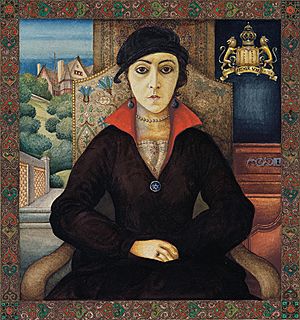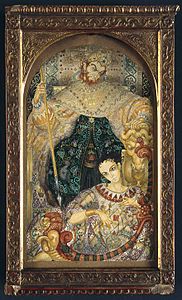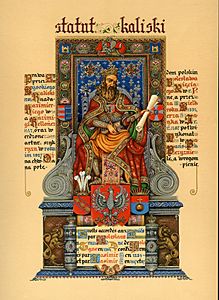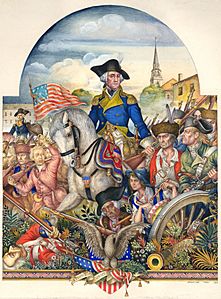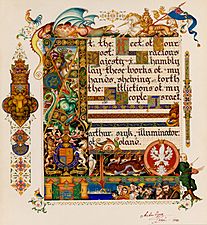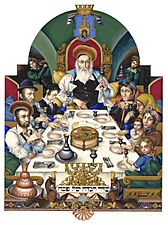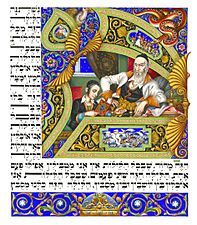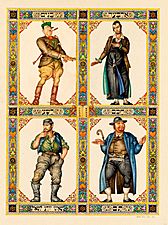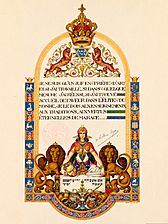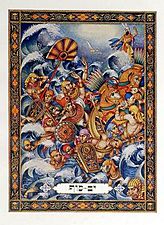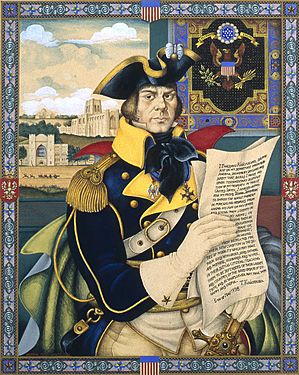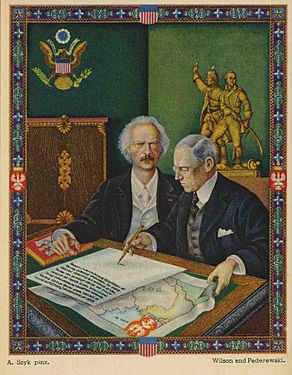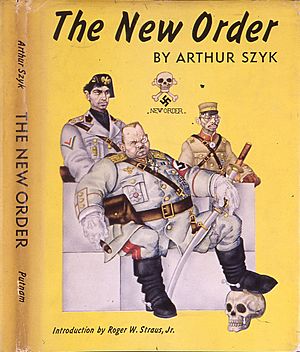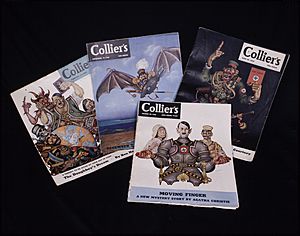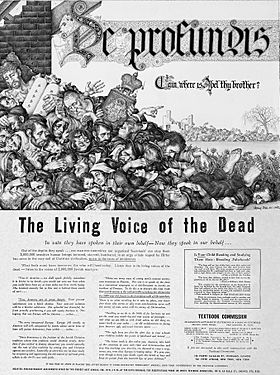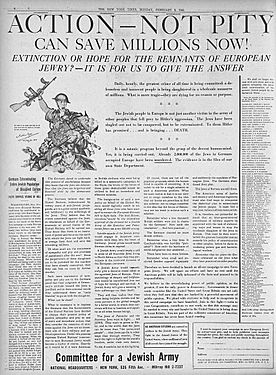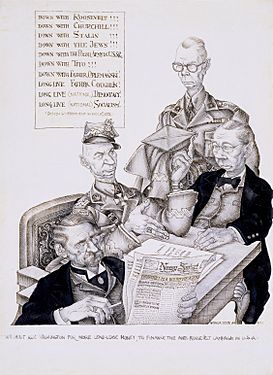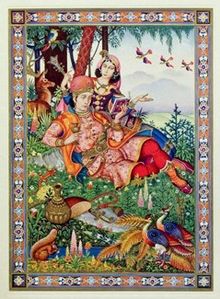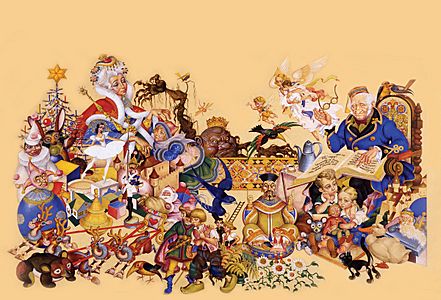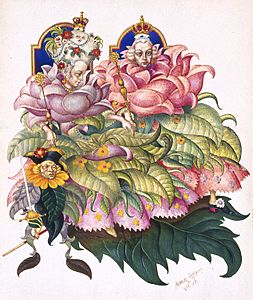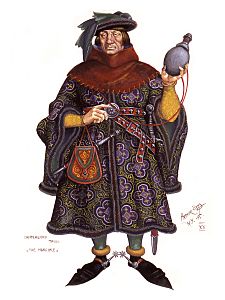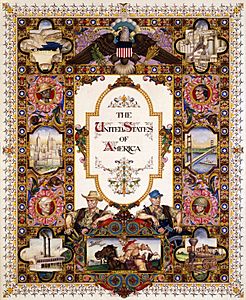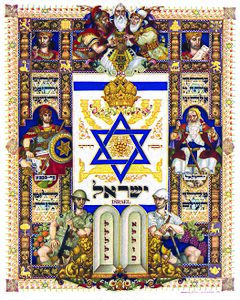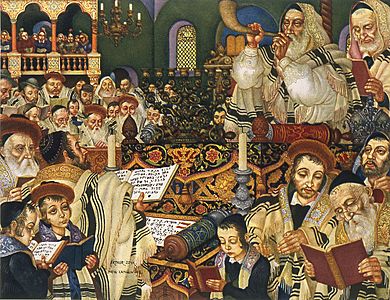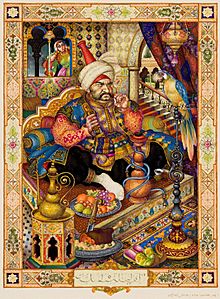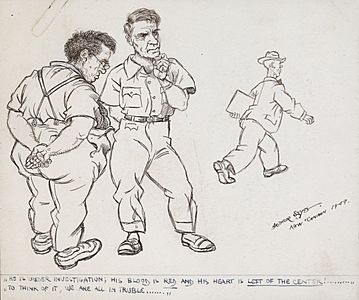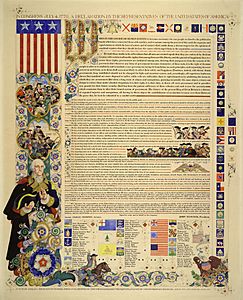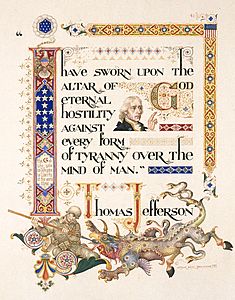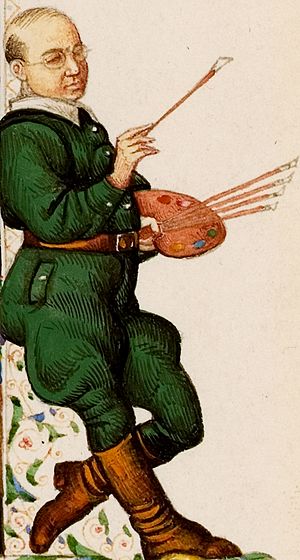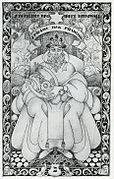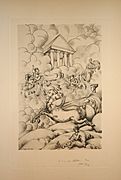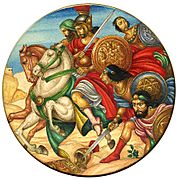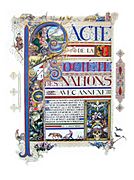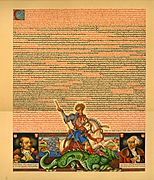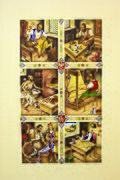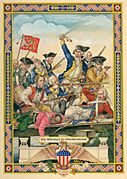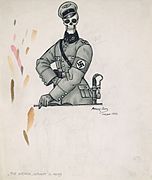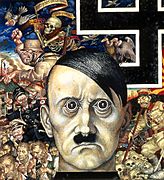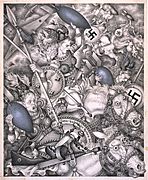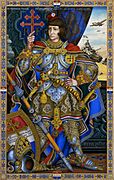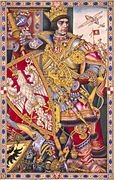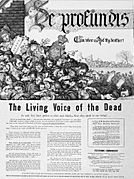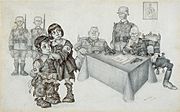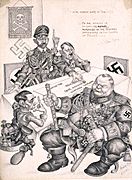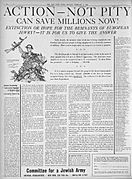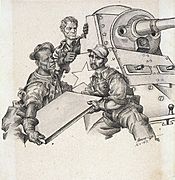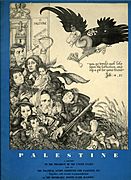Arthur Szyk facts for kids
Quick facts for kids
Arthur Szyk
|
|
|---|---|
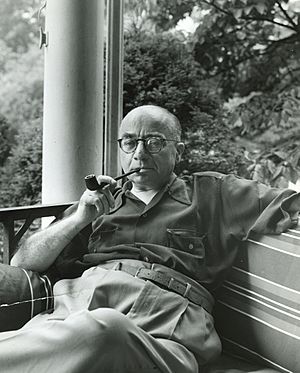
Szyk, circa 1945
|
|
| Born |
Artur Szyk
16 June 1894 Łódź, Vistula Land, Russian Empire
|
| Died | 13 September 1951 (aged 57) |
| Resting place | New Montefiore Cemetery, Farmingdale, New York |
| Nationality | Polish American |
| Education | Académie Julian, Paris Jan Matejko Academy of Fine Arts, Kraków |
| Known for | Drawing, caricature, book illustration, illuminated manuscript, watercolor painting |
|
Notable work
|
Statute of Kalisz (1932); Washington and his Times (1932); Twenty Pictures from the Glorious Days of the Polish-American Fraternity (1939); The Haggadah (1940); The New Order (1941); Andersen's Fairy Tales (1945); Ink & Blood: A Book of Drawings (1946); Pathways Through the Bible (1946); Visual History of Nations (1945–1949) |
| Awards | Ordre des Palmes Académiques (France), 1923; Gold Cross of Merit (Poland), 1931; George Washington Bicentennial Medal (United States), 1932 |
Arthur Szyk (pronounced "Shik") was a talented artist born in Poland. He was Jewish and proud of both his Polish and Jewish heritage. He was born on June 16, 1894, and passed away on September 13, 1951.
Szyk was mostly known for illustrating books and creating political art. He lived in France and Poland for many years. In 1937, he moved to the United Kingdom. Later, in 1940, he settled in the United States and became an American citizen in 1948.
He became famous between World War I and World War II. His art was shown and published in many countries. In the U.S., he became very popular for his political cartoons. These cartoons strongly criticized the leaders of the Axis powers (Germany, Italy, and Japan) during World War II. After the war, he also supported the creation of the state of Israel.
Szyk's art often showed his strong feelings about social and political issues. He liked old art styles, especially illuminated manuscripts from the Middle Ages and Renaissance. These were beautiful, hand-decorated books. He did not follow newer art styles like modernism.
Today, Szyk's work is mainly known and displayed in the United States.
Contents
Early Life and Artistic Beginnings
Arthur Szyk was born in Łódź, Poland, on June 16, 1894. At that time, Poland was under Russian rule. His father, Solomon Szyk, managed a textile factory. When Arthur was six, he already showed a great talent for drawing. He even sketched scenes from the Boxer Rebellion in China.
Even though his family was not strictly religious, Arthur loved drawing stories from the Hebrew Bible. His teachers saw his talent and suggested he study art in Paris. So, he went to Académie Julian, a famous art school. In Paris, he saw many new art styles. But he chose to stick to older traditions. He was especially drawn to medieval art, like the beautiful illuminated manuscripts. This style greatly influenced his future work.
While studying in Paris, Szyk stayed connected to his hometown. Between 1912 and 1914, he drew many political cartoons. These were published in a Polish magazine called Śmiech (meaning "Laughter").
In 1913, Szyk returned to Poland. He continued his art studies in Kraków, which was then under Austrian rule. He was very involved in the city's cultural life. He even designed sets and costumes for a cabaret in Łódź. Szyk was a proud Polish patriot and a proud Jew. He often used his art to speak out against antisemitism, which is prejudice against Jewish people.
In early 1914, Szyk traveled to Palestine with other Polish-Jewish artists. He saw Jewish settlers working to build a future Jewish state. His trip was cut short by the start of World War I. As a Russian citizen, he had to leave Palestine and return home. He was drafted into the Russian army and fought in a battle in Łódź. But he managed to escape in 1915. He spent the rest of the war in his hometown. During his time in the army, he drew Russian soldiers. These drawings were later published as postcards. On September 14, 1916, Arthur Szyk married Julia Likerman. They had a son, George, in 1917, and a daughter, Alexandra, in 1922.
Between the Wars
Poland's Independence and Early Art
After Poland became independent in 1918, Szyk became very active as an artist. He also used his art for political causes. In 1919, he published his first book of political drawings. It was called Revolution in Germany. This book made fun of Germans who seemed to need permission from their leaders even to start a revolution. In the same year, Szyk served in the Polish–Soviet War. He was a cavalry officer and the art director for the Polish army's propaganda team in Łódź.
Life and Art in France
In 1921, Arthur Szyk and his family moved to Paris. They lived there until 1933. This move changed Szyk's art style. Before Paris, his book illustrations were mostly black and white drawings. But in Paris, his illustrations became full of color and amazing detail.
His first book in this new style was the Book of Esther (1925). He also illustrated famous books like The Temptation of Saint Anthony (1926). These colorful and detailed illustrations looked like medieval illuminated manuscripts. Szyk even drew himself as a character in the Book of Esther.
Szyk's art became well-known through exhibitions in Paris. Important people and art collectors bought his drawings. In 1922, he visited Morocco, which was a French protectorate. There, he drew the portrait of the local ruler. For this work, the French government gave him an award called the Ordre des Palmes Académiques. In 1931, he was invited to the League of Nations in Geneva. He started illustrating the League's rules. But he never finished the work because he was disappointed with their actions in the 1930s.
Statute of Kalisz and Washington and his Times
Even while in France, Szyk kept strong ties to Poland. He often visited and showed his art there. In the late 1920s, he worked on illustrating the Statute of Kalisz. This was an old document from 1264 that gave special rights to Jews in Poland.
Szyk created 45 detailed pages for the Statute between 1926 and 1928. His art showed how Jews had contributed to Polish society. For example, he showed their part in Poland's fight for independence. The Statute of Kalisz was published as a book in 1932. Postcards of his illustrations were also popular. His original art was shown in many Polish cities. The Polish government honored him with the Gold Cross of Merit for this work.
Another major series Szyk created was Washington and his Times. He started this in Paris in 1930. This series had 38 watercolors. They showed events from the American Revolutionary War. It was a tribute to the first U.S. president and the American people. This series was shown at the Library of Congress in Washington, D.C., in 1934. Szyk received the George Washington Bicentennial Medal from the American government for it.
The Haggadah and Moving to London
Szyk's art became even more political when Adolf Hitler came to power in Germany in 1933. Szyk started drawing cartoons of Hitler as early as 1933. One drawing showed Hitler dressed as an ancient Egyptian pharaoh. This was a clear reference to the villain in the biblical story of the Exodus.
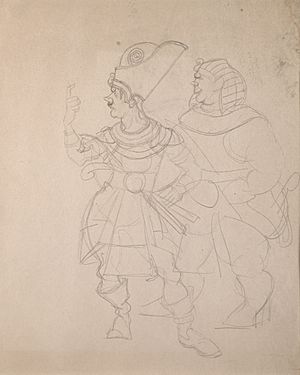
These drawings led to another major series: the Haggadah. The Haggadah is a very important Jewish story about the Exodus of the Israelites from ancient Egypt. It is read every year during the Passover Seder. Szyk illustrated the Haggadah with 48 small paintings between 1934 and 1936. Because of the anti-Jewish policies in Germany, Szyk added modern elements to his art. For example, in the parable of the Four Sons, the "wicked son" looked like a man wearing German clothes with a Hitler-like mustache. In his original version, he even painted swastikas, the symbol of Nazi Germany, on red snakes.
In 1937, Arthur Szyk went to London to oversee the publishing of the Haggadah. The book was finally published in 1940. It was dedicated to King George VI. Critics loved it, with The Times newspaper calling it "one of the most beautiful of books." At the time, it was the most expensive new book in the world.
New York World's Fair, 1939
Before World War II began, Szyk's art was shown at the 1939 New York World's Fair. The Polish section of the fair proudly displayed 23 of his paintings. These works showed the important contributions of Poles to American history. They also highlighted the strong historical ties between Poland and the United States. This was meant to remind people that Poland was a good ally during a difficult time.
World War II and Political Cartoons
Responding to War
When Germany invaded Poland, Arthur Szyk was in Britain. He immediately started creating art about the war. Unlike other cartoonists, Szyk focused on showing the enemy in his works. He rarely drew the leaders or soldiers of the Allied powers. This was a key feature of his art throughout the war. In January 1940, an exhibition of his 72 cartoons opened in London. It was called War and "Kultur" in Poland and was very well received.
Szyk drew more and more cartoons attacking the Axis powers and their leaders. His popularity grew steadily. In 1940, an American publisher offered to publish a collection of his drawings. Szyk agreed, and the book The New Order came out in 1941. This was months before the United States joined the war.
Moving to the United States
In July 1940, Szyk moved from Britain to North America. He was asked to help spread awareness about the fight against Nazism. He first went to Canada, where the media welcomed him warmly. They wrote about his dedication to fighting Nazi Germany. One newspaper even reported that Hitler had supposedly put a reward on Szyk's head.
In December 1940, Szyk and his family moved to New York City. His son, George, joined the Free French Forces. Soon after arriving in the U.S., Szyk was inspired by President Roosevelt's "Four Freedoms" speech. He created illustrations for the Four Freedoms, which were used on posters and stamps during the war.
Szyk became incredibly popular in the U.S. after the Japanese attack on Pearl Harbor. His cartoons of Axis leaders like Hitler, Mussolini, and Hirohito appeared everywhere. They were in newspapers, magazines like Time and Collier's, on posters, and postcards. He even created advertisements for companies like Coca-Cola. His art was shown in many galleries and museums, including the White House. Over 25 exhibitions of his work were held in the U.S. during the war.
At the end of the war, in 1945, his drawing Two Down and One to Go was used in a film. This film encouraged American soldiers to make a final push against Japan. Esquire magazine reported that Szyk's posters were even more popular with American soldiers than pin-up girls. More than a million American soldiers saw Szyk's art.
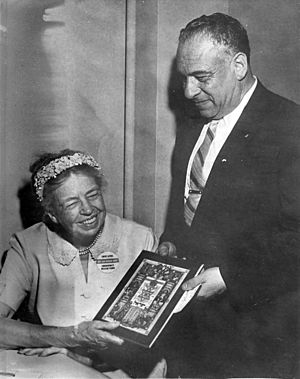
Eleanor Roosevelt, the First Lady, often wrote about Szyk in her newspaper column. She praised his efforts in the fight against Nazism and Fascism.
Speaking Out for Justice
Even though Szyk strongly opposed Nazi Germany, he also criticized the Allies at times. He criticized the United Kingdom for limiting Jewish immigration to Palestine. He also spoke out against American-Jewish groups for not doing enough to help European Jews. Szyk supported efforts to raise public awareness about the terrible fate of Jews in Europe. He illustrated full-page advertisements in The New York Times for this cause.
Szyk also spoke out against racial unfairness in the United States. He criticized the fact that Black people did not have the same rights as white people. In one drawing, a Black soldier tells a white soldier that he would make Hitler Black and drop him in the U.S.A. This showed the unfairness of racism.
Szyk's views on his home country, Poland, were complex. He saw himself as both Jewish and Polish. He showed the suffering of Poles in his drawings. However, he sometimes criticized the Polish government-in-exile, especially towards the end of the war. Around 1943, Szyk also changed his views on the Soviet Union. His 1944 drawing showed a Polish soldier and a Red Army soldier together, both liberating Poland.
Book Illustrations During War
Even though cartoons were a big part of Szyk's art during the war, he still illustrated books. In 1940, an American publisher asked him to illustrate the Rubaiyat, a collection of poems. In 1943, he started working on illustrations for the Book of Job, which was published in 1946. He also illustrated fairy tales by Hans Christian Andersen (Andersen's Fairy Tales, 1945).
-
Rubáiyát of Omar Khayyám (1940), New York.
Postwar Years and Legacy
In 1945, Arthur Szyk and his family moved to New Canaan, Connecticut. He lived there until he passed away. After the war, he no longer needed to create cartoons against Nazism. A large collection of his war drawings was published in a book called Ink and Blood in 1946.
Szyk returned to illustrating books. He worked on The Canterbury Tales and many books about Bible stories. These included Pathways through the Bible (1946) and The Book of Job (1946). Some of his illustrated books were published after his death, like The Arabian Nights Entertainments (1954). He also designed stamp album covers for many countries, including the United States and Israel.
-
Visual History of Nations, Israel (1948), New Canaan, Connecticut.
-
The Holiday Series, Rosh Hashanah (1948), New Canaan, Connecticut.
Arthur Szyk became an American citizen on May 22, 1948. But he said the happiest day of his life was May 14, when the state of Israel was declared independent. He celebrated this by creating a beautifully decorated version of the Hebrew declaration. Two years later, in 1950, he also showed a richly illustrated version of the United States Declaration of Independence.
Szyk continued to be politically active. He criticized McCarthyism, a time when people were unfairly suspected of being communists. He also spoke out against racism. One of his famous drawings from 1949 showed members of the Ku Klux Klan approaching a tied-up African American. The caption read, "Do not forgive them, oh Lord, for they do know what they do." Because he spoke his mind, Szyk was sometimes suspected by government committees. However, he denied any sympathy for communism.
-
McCarthyism – "He is Under Investigation, His Blood is Red and His Heart is Left of Center!..." (1949), New Canaan, Connecticut.
Arthur Szyk passed away from a heart attack in New Canaan on September 13, 1951.
Szyk's Art Today
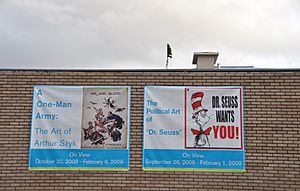
After his death, Szyk's great popularity slowly faded. From the 1960s to the late 1980s, his art was rarely shown in American museums. This changed in 1991 when a group called The Arthur Szyk Society was formed. Its founder, George Gooche, helped bring Szyk's works back into public view.
The Society has organized many exhibitions of Szyk's art in American cities. They also have a large educational website and publish information about the artist. In 2017, a collection of 450 of Szyk's paintings and drawings was bought by the University of California, Berkeley. This was a huge gift and the largest ever to acquire art for the university.
Recent exhibitions of Szyk's work include:
- "Arthur Szyk: Soldier in Art", New-York Historical Society, New York City (2017-2018)
- "Arthur Szyk and the Art of the Haggadah", Contemporary Jewish Museum, San Francisco (2014)
- "Arthur Szyk: Miniature Paintings and Modern Illuminations", California Palace of the Legion of Honor, San Francisco (2010-2011)
- "A One-Man Army: The Art of Arthur Szyk", Holocaust Museum Houston (2008-2009)
- "Arthur Szyk – Drawing Against National Socialism and Terror", Deutsches Historisches Museum (DHM), Berlin, Germany (2008-2009)
- "The Art and Politics of Arthur Szyk", United States Holocaust Memorial Museum, Washington, D.C. (2002)
- "Arthur Szyk: Artist for Freedom", Library of Congress (1999-2000)
- "Justice Illuminated: The Art of Arthur Szyk", Spertus Institute, Chicago (1998-1999) – this exhibition also traveled to Poland.
- "In Real Times. Arthur Szyk: Art & Human Rights (1926-1951)" The Magnes Collection of Jewish Art and Life, University of California, Berkeley (2020 – present)
Gallery
-
Arthur Szyk, 1942, Anti-Christ, watercolor and gouache on paper. Szyk's portrayal of Adolf Hitler as the embodiment of evil: his eyes reflect human skulls, his black hair the Latin words "Vae Victis" [woe to the vanquished (ones)].
-
De Profundis - Cain, Where is Abel Thy Brother? as published in the Chicago Sun, 1943.
-
Tears of Rage - "Action, Not Pity" as published in The New York Times, 1943.


